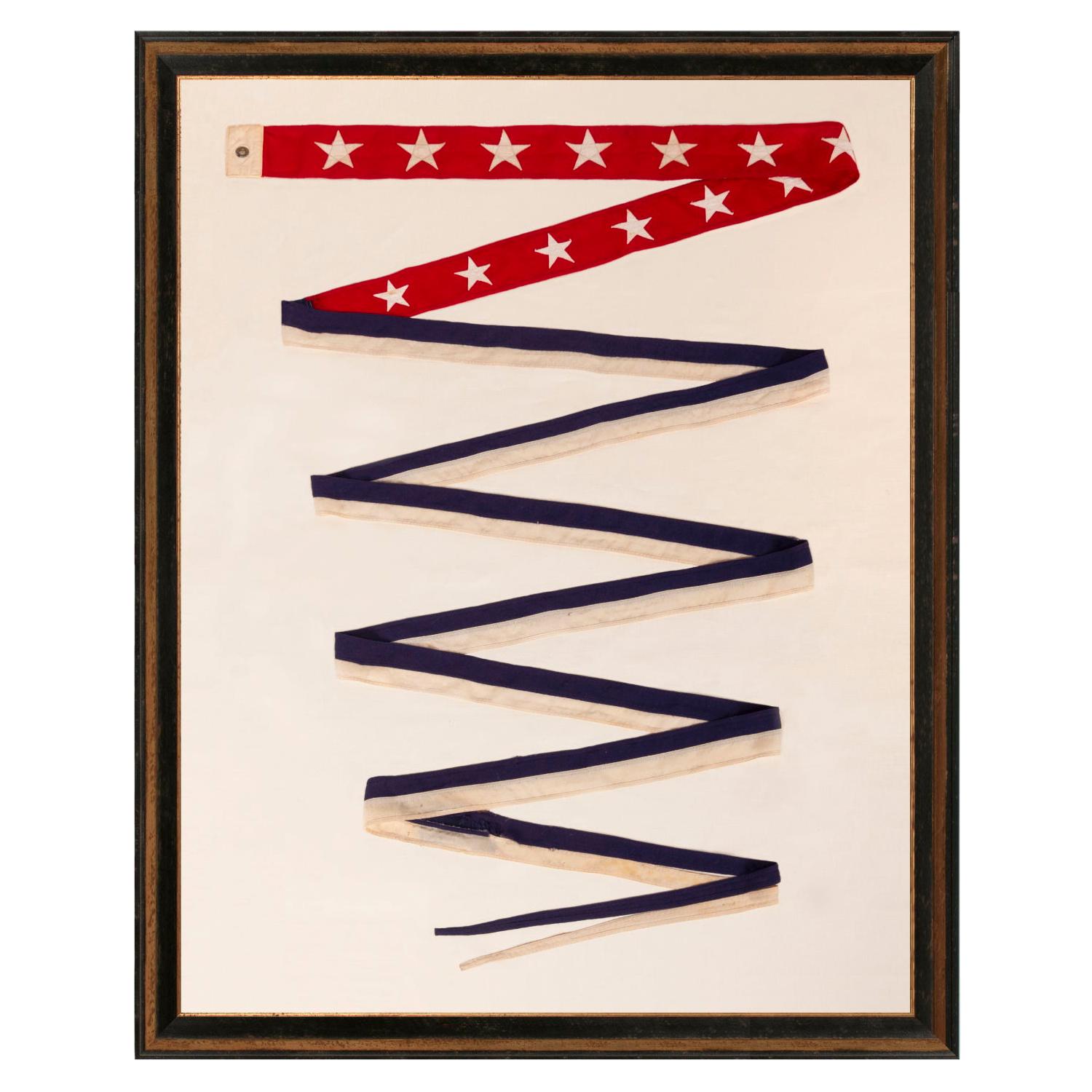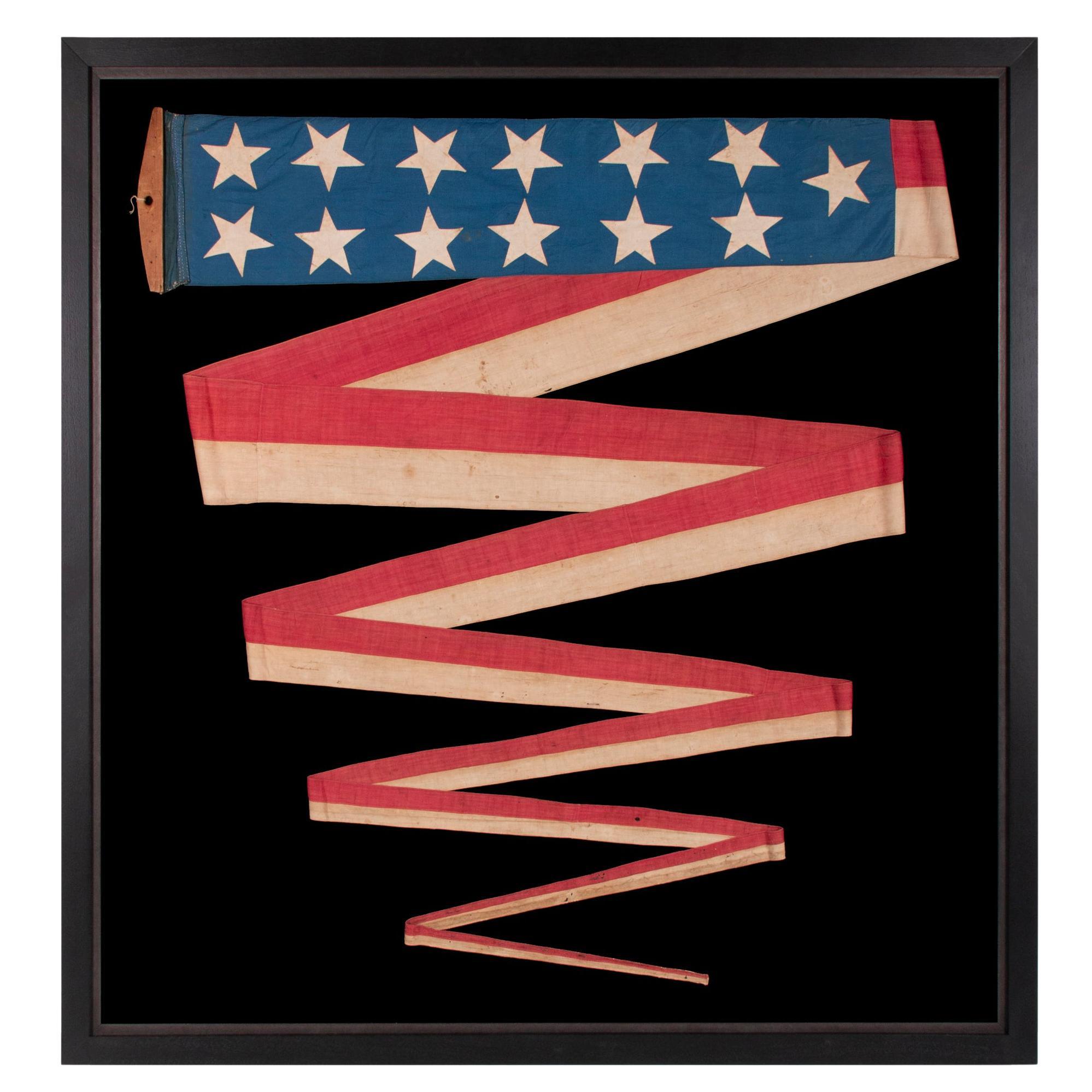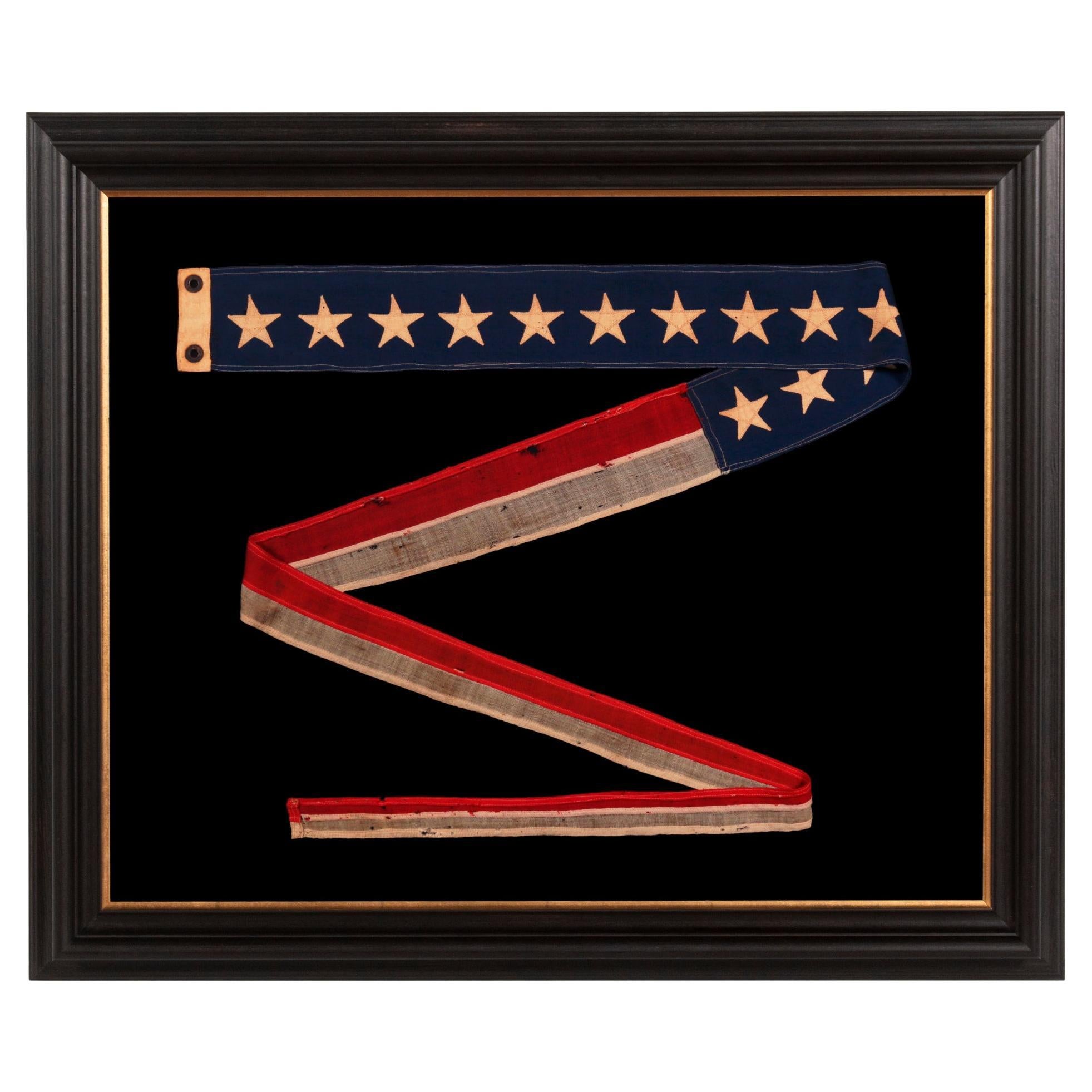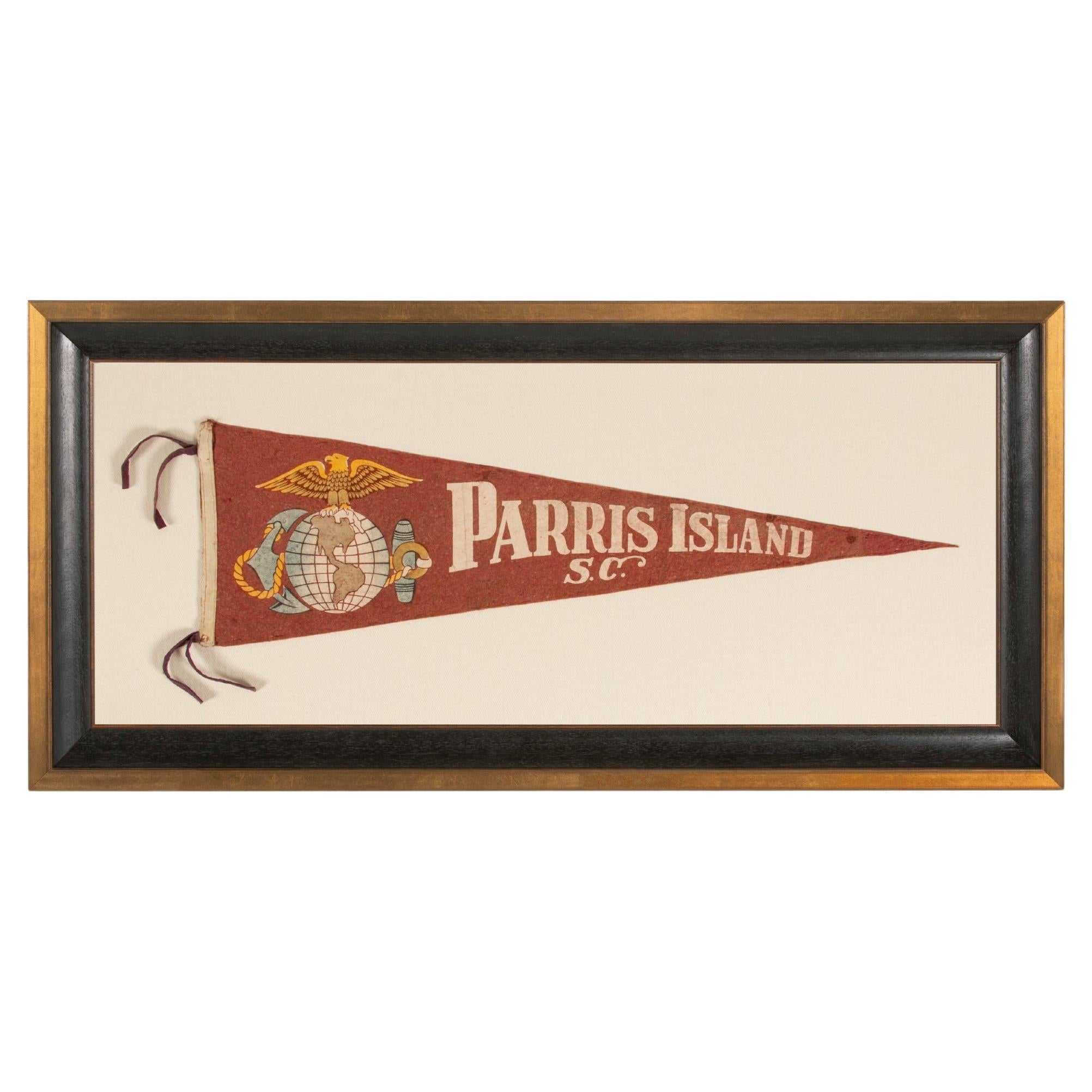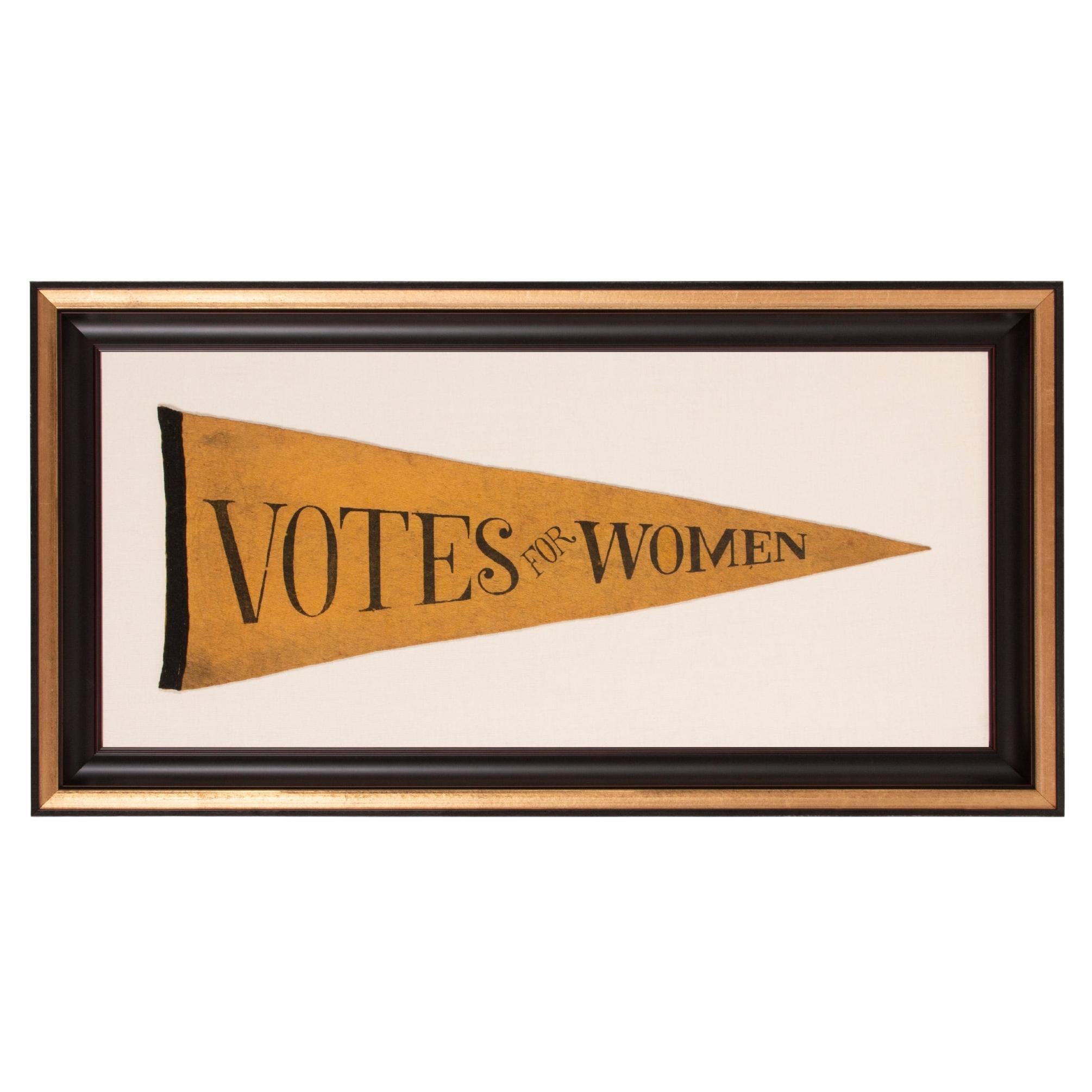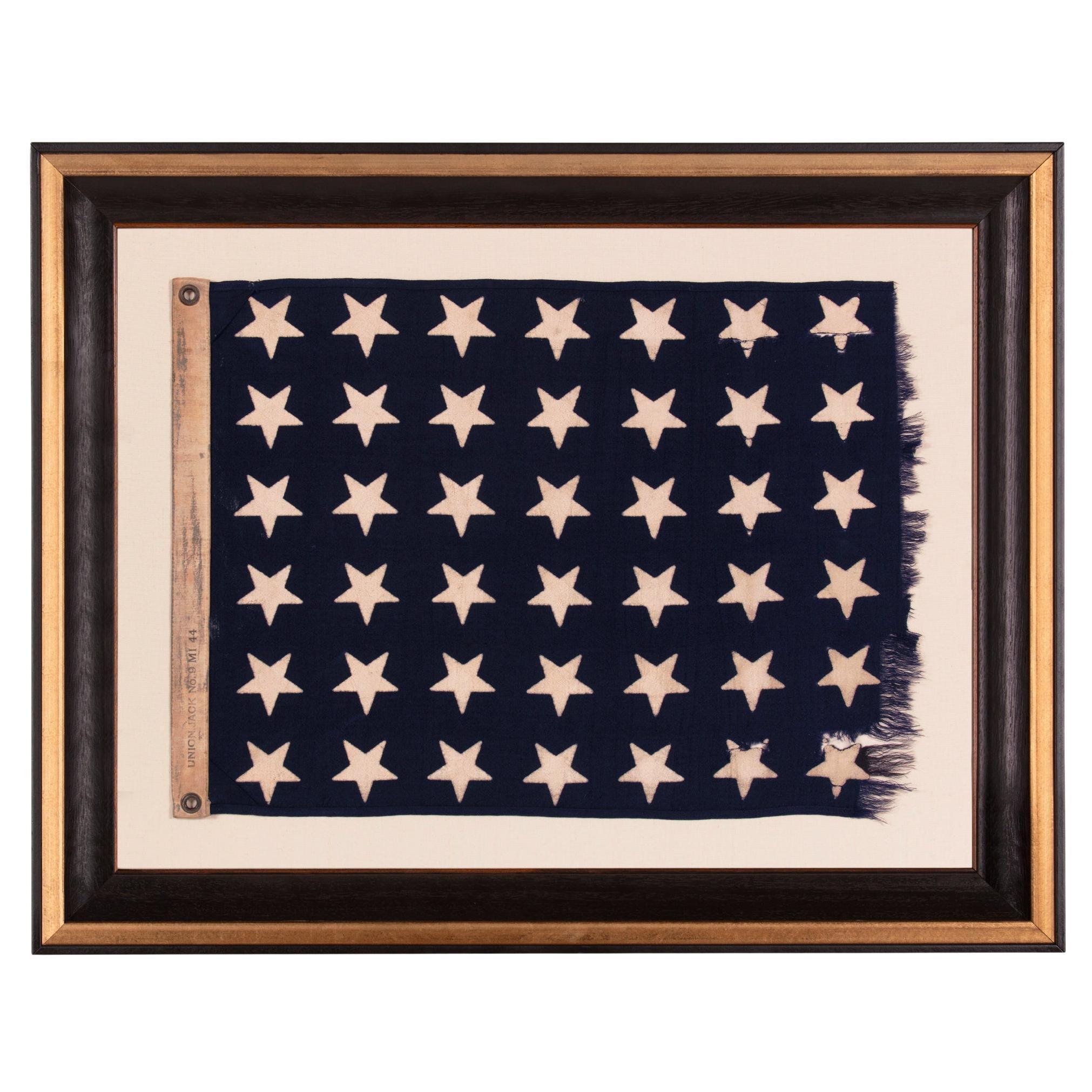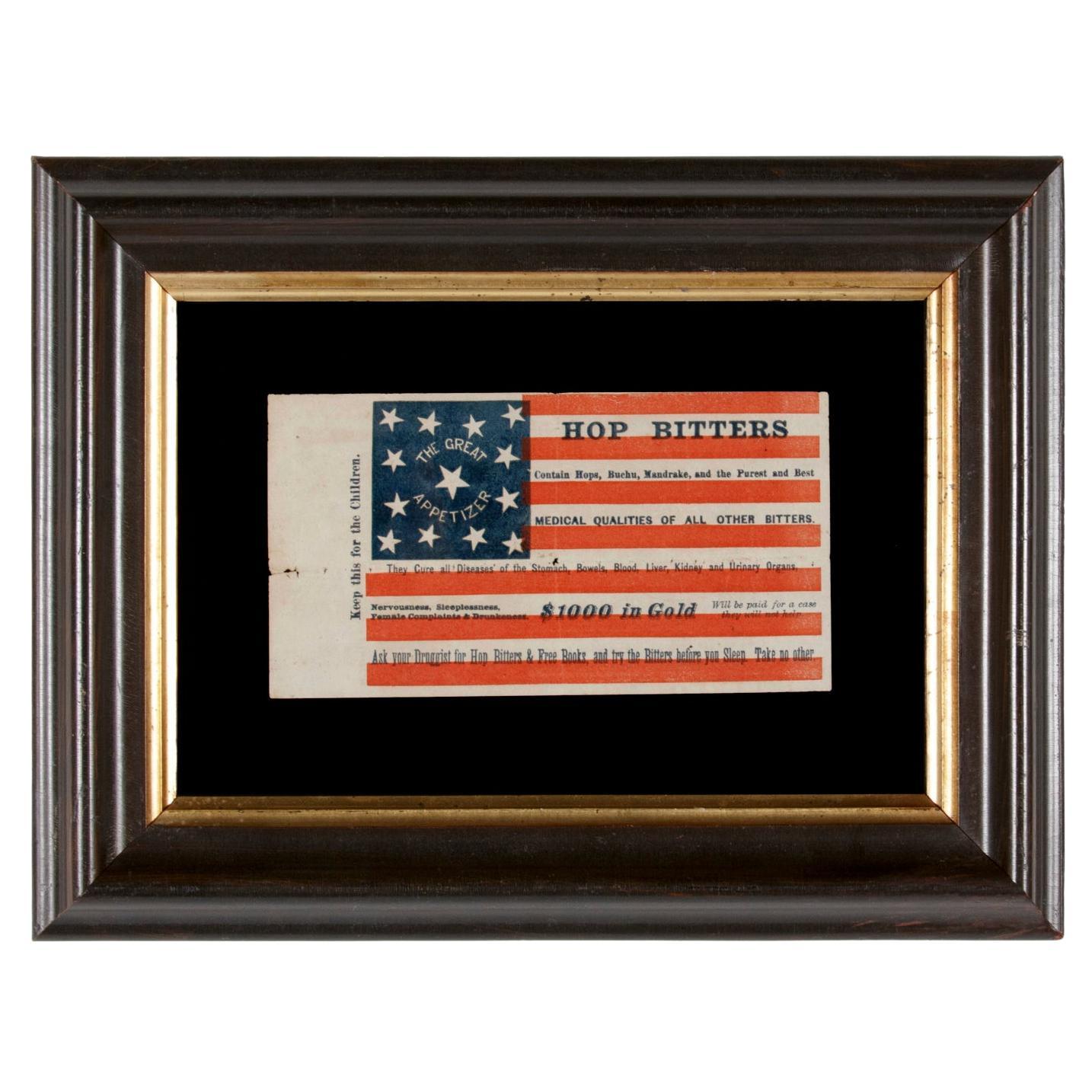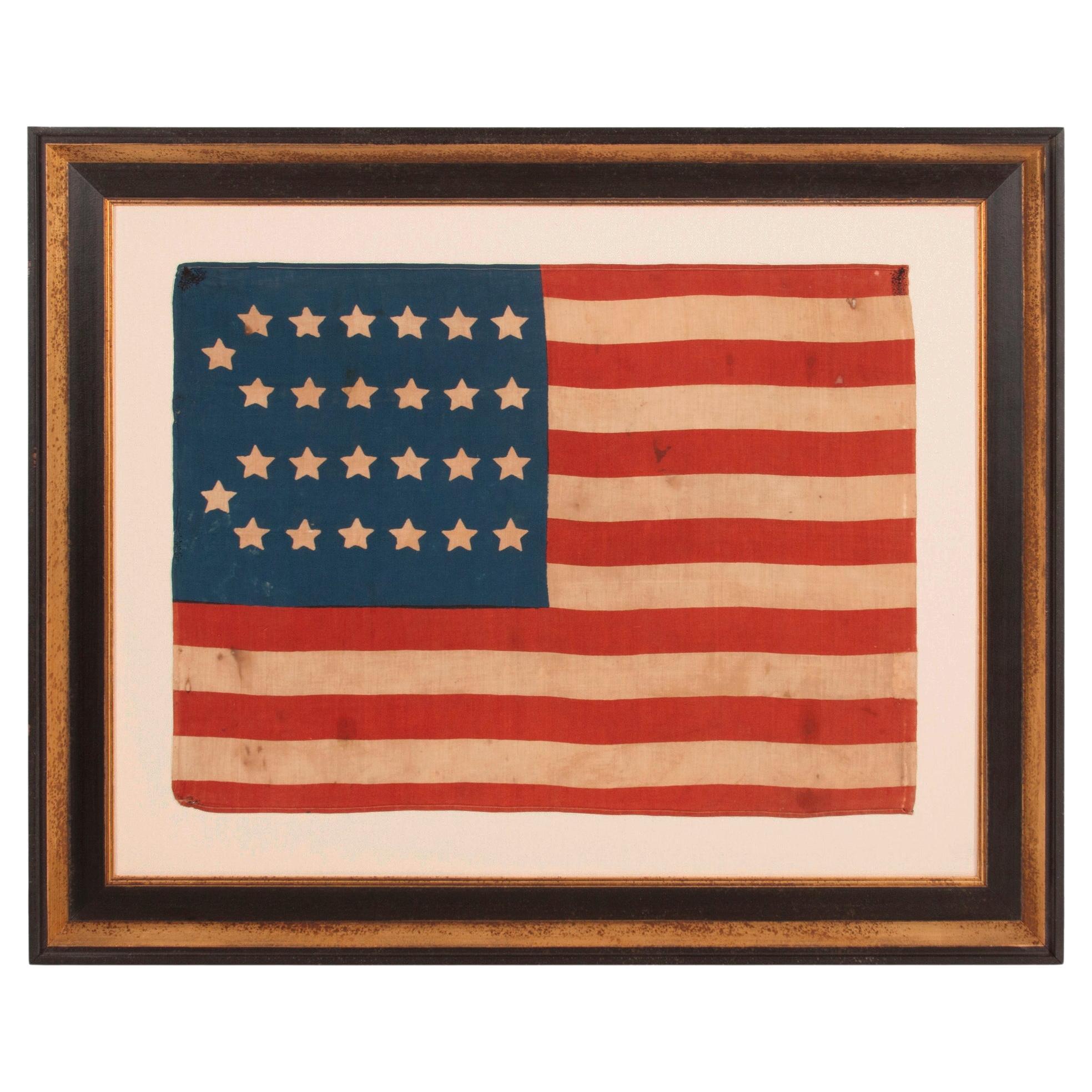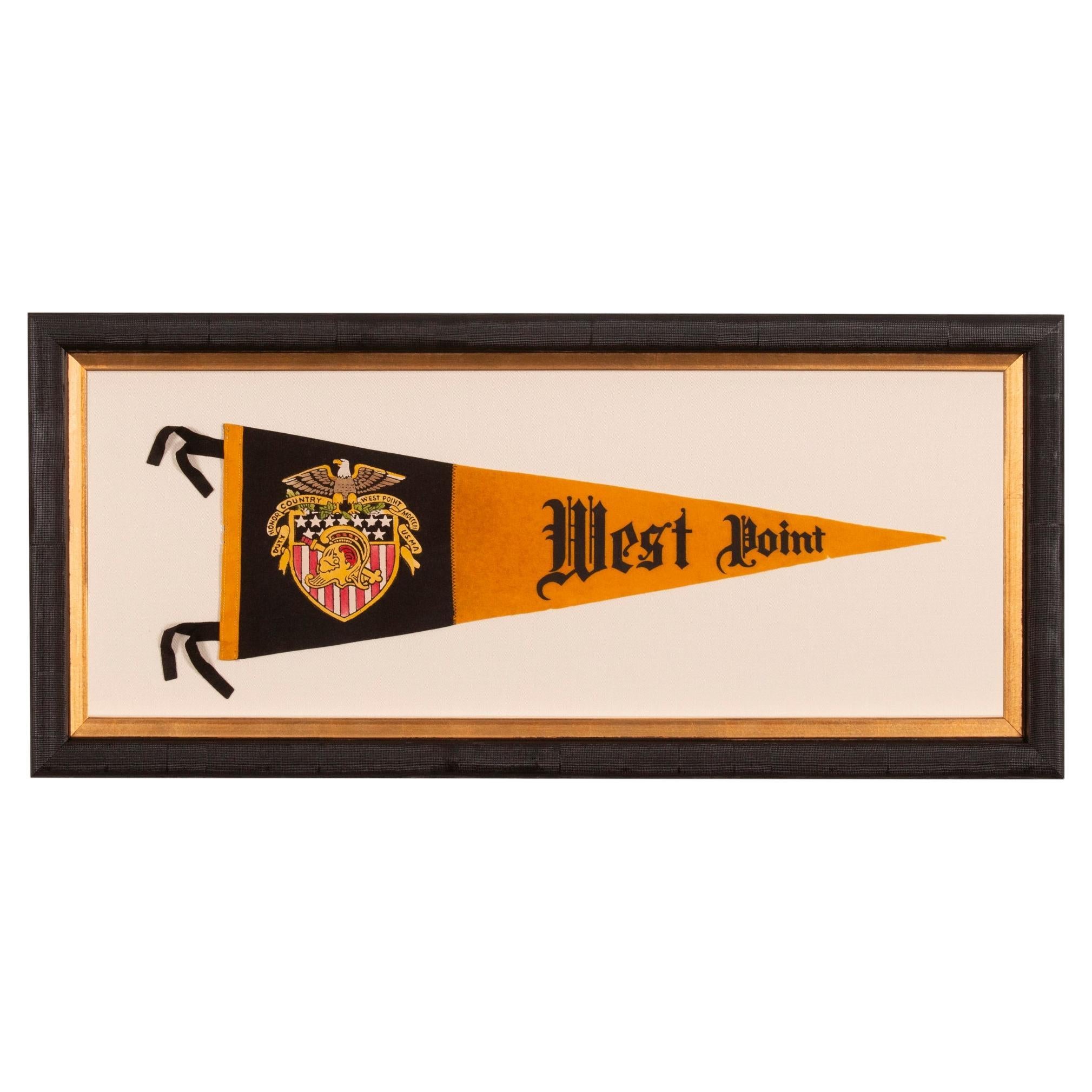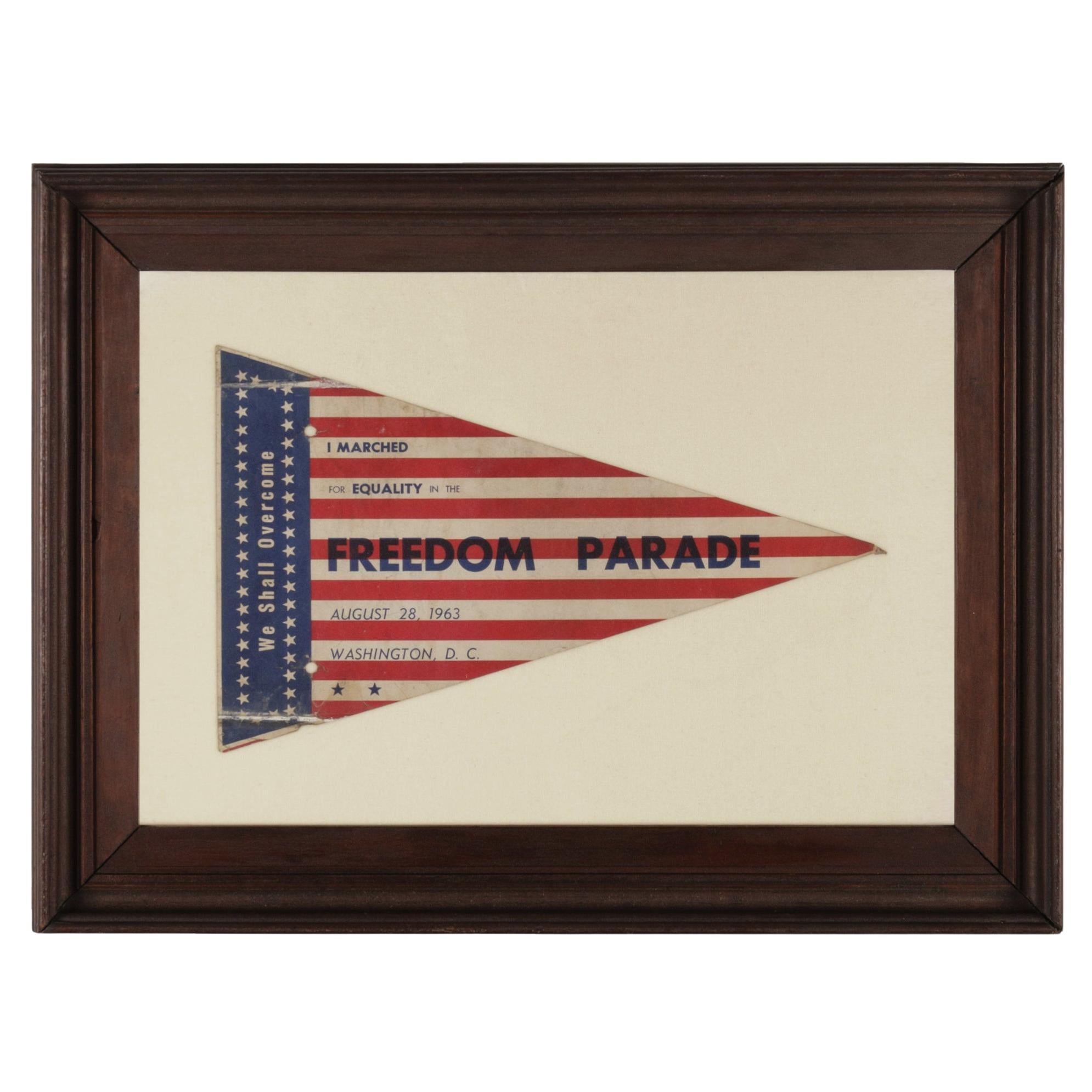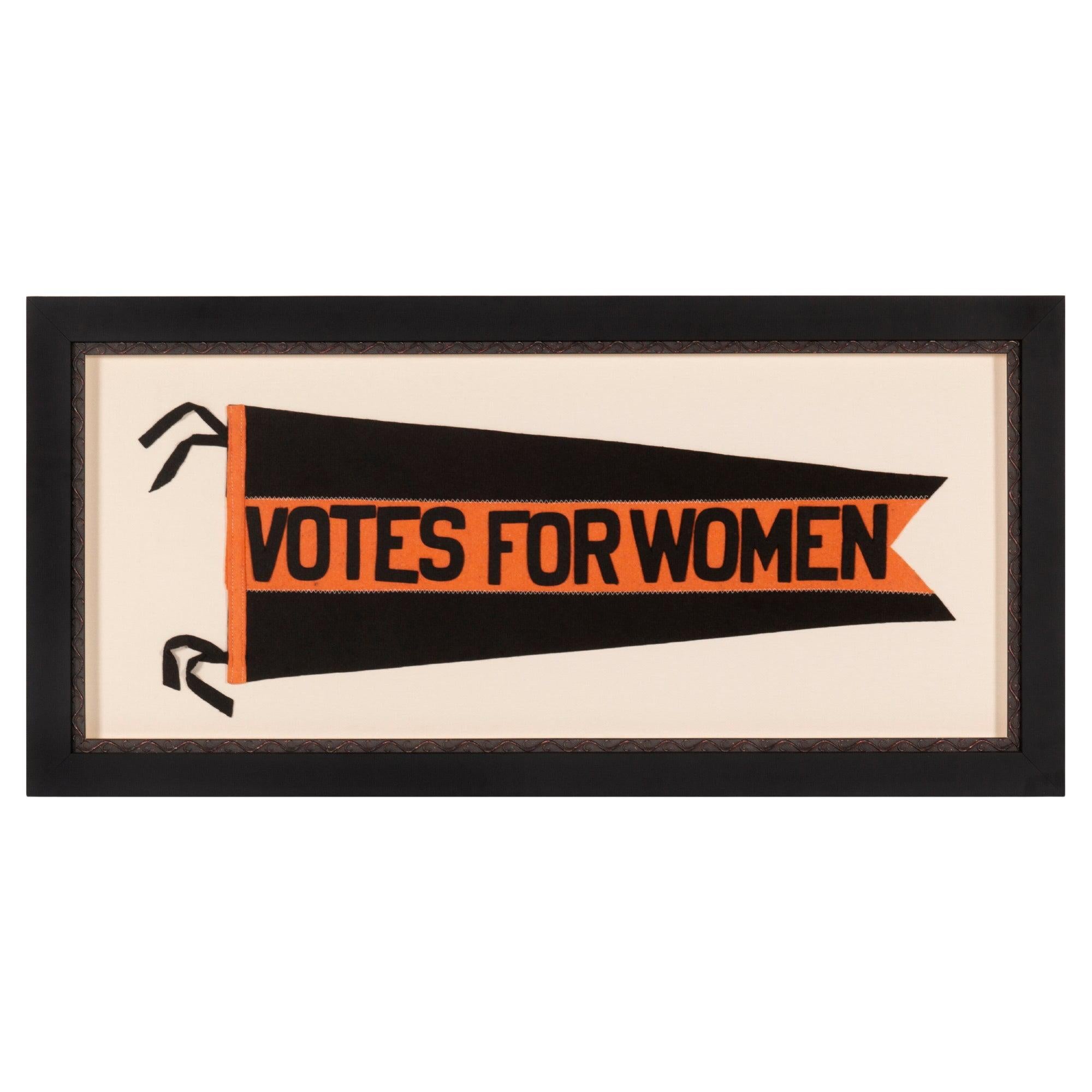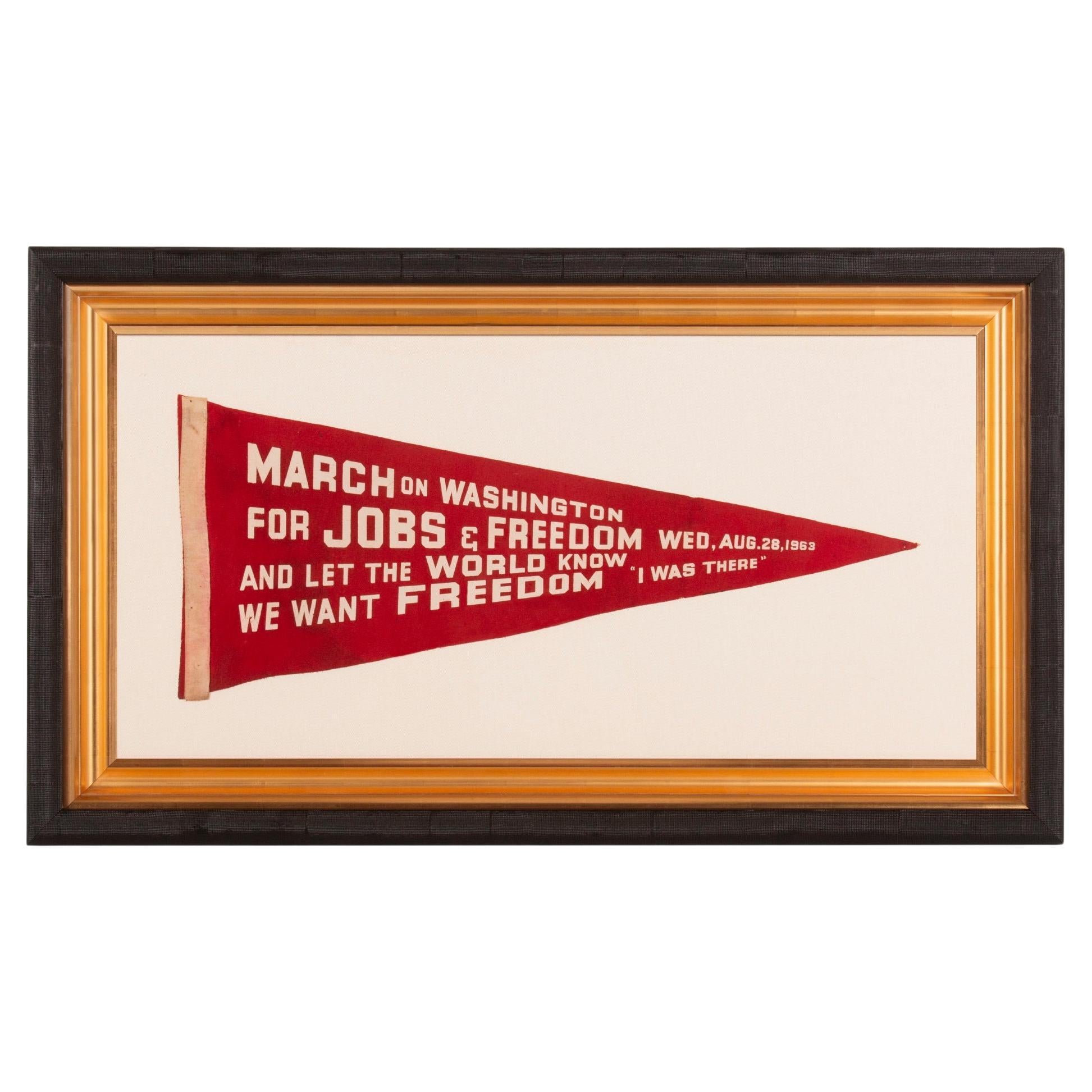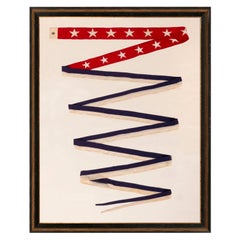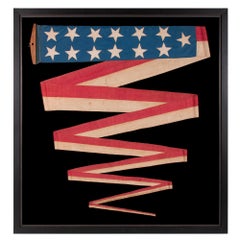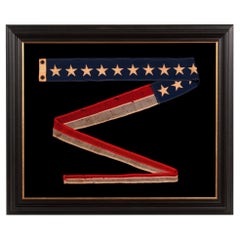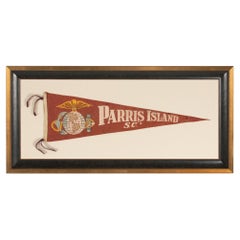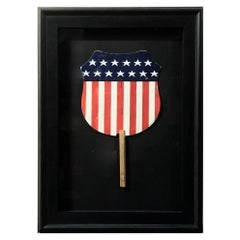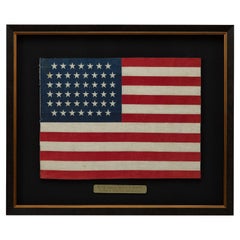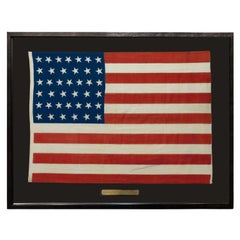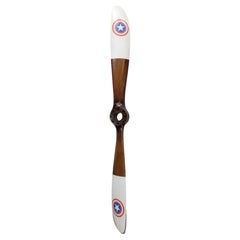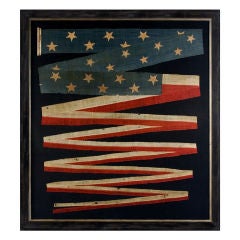
Rare 26 Star U.s. Navy Commissioning Pennant
View Similar Items
Want more images or videos?
Request additional images or videos from the seller
1 of 6
Rare 26 Star U.s. Navy Commissioning Pennant
About the Item
Commissioning pennants are the distinguishing mark of a commissioned U.S. Navy ship. A ship became commissioned when this pennant was hoisted. Flown during both times of peace and war, the only time the pennant is not flown is if a flag officer or civilian official is aboard and replaces it with their own flag.
In 18th and early 19th century America, these pennants would typically have a number of stars that reflected the number of official star on the American national flag. That is the case with this 26 star example, which is one of the earliest that I have ever owned. As time progressed, more and more states were added, and number of stars was reduced to either 13 stars, to reflect the original number of states, or 7 stars. According to the U.S. Navy, the reason for the choice of 7 stars was not recorded. I have suggested that this number may have been chosen to stand for the 7 seas, but it may just have well have been for some other purpose. Whatever the case may be, after the turn of the 20th century (1900), most pennants had 7 stars.
This particular pennant is one of the earliest I have ever owned. Its 26 stars reflect the addition of Michigan in 1836. The 26 star flag became official on July 3rd, 1837, and remained so until after the addition of the 27th state (Florida) in 1845. Flags made prior to the Civil War are very rare, comprising less than one percent of 19th century flags that exist in the 21st century.
Measuring 55 feet on the fly, this is the longest commissioning pennant that I have ever acquired. During the 18th and 19th centuries, commissioning pennants were a very important means of identifying and U.S. Navy ship on the open seas. For this reason, they often well-exceed twenty feet in length, with some reaching as long as ninety feet. By the 20th century, however, they had become largely ceremonial and customary. Today the largest commissioning pennants measure two-and-a-half inches by six feet, while some are as short as 4 feet on the fly.
The pennant is entirely hand-sewn, which is expected in this early period that predates the use of sewing machines. Note the wonderful coloration of the canton, which falls somewhere between Prussian blue and teal and creates a beautiful contrast with the deep scarlet and ivory white of the field, the terminates in a blunt-ended swallowtail. The body of the flag is made of wool bunting, which has a loose weave that is also indicative of the 1837-1845 timeframe. This is a transitional window in early flag-making, so other styles of wool can be seen in the flags of this era, but this particular fabric is spot-on in terms of what one should expect.
The stars are made of cotton, hand-sewn, and single-appliquéd. This means that they were applied to one side of the canton, then the blue fabric was cut from behind each star, folded over, and under-hemmed so that one appliquéd star could be visible on both sides of the flag. The hoist is made of a wooden bar that has been covered in coarse linen or hemp and there are three, hand-sewn, whip-stitched grommets.
The initials “J.D.T.” are penned on one side of the header. This might be the initials of a naval officer who possessed the flag at some point in its history. One the other side is the name of a subsequent owner, “W.H. Bartlett”, and the date “1894”. It was very common during the 19th century for persons to mark flags to indicate ownership, either with full names or initials.
In summary, this is a first rate example of a U.S. Navy commissioning pennant from what is considered a very early point in American history with respect to surviving flags, and it’s an extraordinarily large example with great colors, desirable construction, and in tremendous condition.
Mounting: The pennant has been hand-stitched to 100% cotton, black in color, which has been washed to reduce excess dye. An acid-free agent was added to the wash to further set the dye, which was heat-treated for the same purpose. The mount was then placed in a black-painted, hand-gilded and distressed, Italian molding. The front is U.V. protective acrylic.
Condition: There is minor mothing throughout, accompanied by minor staining, but both of these issues are remarkably limited for such an early flag. The fact that it appears to retain its full length is also especially unusual. While the pennant appears to have been flown, its use was apparently limited.
- Place of Origin:
- Period:
- Date of Manufacture:1837-1845
- Condition:See Item Description.
- Seller Location:York County, PA
- Reference Number:Seller: 26j-8191stDibs: U1101108497323
About the Seller
5.0
Recognized Seller
These prestigious sellers are industry leaders and represent the highest echelon for item quality and design.
Established in 1991
1stDibs seller since 2008
70 sales on 1stDibs
Typical response time: 1 to 2 days
Authenticity Guarantee
In the unlikely event there’s an issue with an item’s authenticity, contact us within 1 year for a full refund. DetailsMoney-Back Guarantee
If your item is not as described, is damaged in transit, or does not arrive, contact us within 7 days for a full refund. Details24-Hour Cancellation
You have a 24-hour grace period in which to reconsider your purchase, with no questions asked.Vetted Professional Sellers
Our world-class sellers must adhere to strict standards for service and quality, maintaining the integrity of our listings.Price-Match Guarantee
If you find that a seller listed the same item for a lower price elsewhere, we’ll match it.Trusted Global Delivery
Our best-in-class carrier network provides specialized shipping options worldwide, including custom delivery.More From This Seller
View AllU.S War Department Commissioning Pennant with 13 Stars
Located in York County, PA
EXTREMELY RARE U.S. WAR DEPARTMENT COMMISSIONING PENNANT WITH 13 STARS, A REVERSAL OF THE U.S. NAVY COLOR SCHEME, TWENTY-FOUR FEET ON THE FLY, SP...
Category
20th Century American Political and Patriotic Memorabilia
Materials
Wool
Price Upon Request
Hand-Sewn 13 Star Cornflower Blue 32 Foot Commission Pennant circa 1845-1865
Located in York County, PA
ENTIRELY HAND-SEWN, 32-FOOT, SHIP’S COMMISSION PENNANT OF THE 1845-1865 ERA, A HOMEMADE, COTTON EXAMPLE, WITH 13 STARS ON A CORNFLOWER BLUE CANTON, IN A BEAUTIFUL STATE OF PRESERVATION
Commission pennants are the distinguishing mark of a commissioned U.S. Navy ship. A ship becomes commissioned when the pennant is hoisted. Flown during both times of peace and war, the only time it is not flown is if a flag officer or civilian official is aboard and replaces it with their own flag. Flown at the topmast, this would be the first thing one would see coming over the horizon and identified the vessel as a warship.
Sometimes the owners of private ships mimicked the use of Navy signals. Some seafaring men would have served in the Navy and become privy to various practices in that capacity. Others flew them purely for stylistic reasons, either on a regular basis or while the boat was dressed for special occasion. Hudson River steamers regularly flew pennants of this nature, as evidenced by period photography as well as the paintings of artists such as John and James Bard...
Category
Antique Mid-19th Century American Political and Patriotic Memorabilia
Materials
Cotton
Commission Pennant with 13 Stars, like for Private Vessel, Ca 1892-1910
Located in York County, PA
Commission pennants are the distinguishing mark of a commissioned U.S. Navy ship. Flown at the topmast, the typical American format is a long blue field, usually with a single row of white stars, although sometimes with their total divided into two rows, followed by two long stripes, red-over-white. A ship became commissioned when this pennant was hoisted. Flown during both times of peace and war, the only time the pennant is not flown is if a flag officer or civilian official was aboard and replaced it with their own flag.
Sometimes the owners of private ships mimicked the use of Navy signals. Some seafaring men would have served in the Navy and become privy to various practices in that capacity. Others flew them purely for stylistic reasons, either on a regular basis or while the boat was dressed for special occasion. Hudson River steamers regularly flew pennants of this nature, as evidenced by period photography as well as the paintings of artists such as John and James Bard...
Category
Antique Late 19th Century American Political and Patriotic Memorabilia
Materials
Wool
Price Upon Request
United State Marine Corps Parris Island Pennant ca 1917-1930
Located in York County, PA
UNITED STATES MARINE CORPS PENNANT FROM PARRIS ISLAND, circa WWI (U.S. INVOLVEMENT 1917-18) -1930’s
Faded, red, felt, United States Marine Corps pennant with a variant of the central device of its official seal printed in blue, yellow, gold, tan, and white pigments, and “Parris Island S.C.” in white beyond, slightly arched, extending toward the tapered point. Note the whimsical profile of the letter “c,” with an exaggerated, scrolling tail. The device generally consists of a federal eagle perched upon a globe, superimposed on a canted anchor with a whirling chain, the combination of which is to symbolize the Corps’ watchful, worldwide, maritime presence. In this instance the image was modified to fit the elongated profile of a pennant’s basic design, with the anchor rotated slightly clockwise to the horizontal, an adaptation sometimes encountered in both Marine Corps and U.S. Navy examples.
The colors used to represent the Marine Corps changed over time. The present combination of scarlet red and gold, predominant here, were formally adopted in 1925, but American military traditions tend to be as hard to extinguish as the men and women of their ranks, and the Corps was certainly no exception. 14 years would pass before the official change caught up with the Marine Corps’ flag...
Category
Early 20th Century Political and Patriotic Memorabilia
Materials
Felt
American Suffrage Movement 'Votes for Women" Pennant, circa 1912-1920
Located in York County, PA
AMERICAN SUFFRAGE MOVEMENT PENNANT WITH "VOTES FOR WOMEN" TEXT, IN A LARGE SIZE AND WITH ATTRACTIVE PATINA FROM AGE AND OBVIOUS USE, circa 1912-1920
American Suffrage movement penna...
Category
Early 20th Century American Political and Patriotic Memorabilia
Materials
Felt
Price Upon Request
48 Star US Navy Jack Made at Mare Island, California, Dated 1944
Located in York County, PA
48 STAR U.S. NAVY JACK, MADE AT MARE ISLAND, CALIFORNIA, HEADQUARTERS OF THE PACIFIC FLEET, DURING WWII, DATED 1944
United States Navy jack with 48 stars, made during WWII (U.S. inv...
Category
Vintage 1940s American Political and Patriotic Memorabilia
Materials
Wool
Price Upon Request
You May Also Like
U.S. Shield Patriotic Printed Paddle Fan, Circa 1918
Located in Colorado Springs, CO
Presented is a U.S. shield patriotic printed paddle fan from 1918. The blue chief is printed with thirteen white stars. Below, thirteen vertical pales are printed in alternating red ...
Category
Vintage 1910s American Political and Patriotic Memorabilia
Materials
Wood, Paper
46-Star American Flag Printed in Drum Star Configuration
Located in Colorado Springs, CO
This is an original 46-Star American parade flag, celebrating Oklahoma statehood. Each star on the flag's canton represents a state in the Union at the time. The official flag design would update every July 4th, to include any new states added to the Union in the past year. Oklahoma, the 46th state, entered the Union on November 16, 1907. As such, this 46–star flag was the official flag of the United States from July 4, 1908, until July 4, 1912.
The silk flag has a dark blue canton with 46 white printed stars. The stars are printed in an 7-8-8-8-8-7 row configuration, or “Drum design.” The flag design is completed with 13 alternating red and white stripes, each stripe representing one of the original thirteen colonies.
The land that comprises Oklahoma today was added to the United States as part of the Louisiana Purchase of 1803. Throughout the 19th century, the U.S. government relocated Indian tribes from the southeastern United States to the area, and by 1900, over 30 Indian tribes had been moved to what was originally called the Indian Territories. At the same time, ranchers in Texas began to move into the area in search of new pasture lands. Although stipulations in the Indian Relocation Act agreed that the land would forever be Indian Territory, the promise of fertile farmland trumped the government’s promise of sovereignty.
On April 22, 1889, they opened the land to settlement by homesteaders, creating a land run in which settlers, called “Boomers,” were allowed to cross the Texas or Arkansas border at a particular hour to claim homesteads. Settlers who illegally crossed the border earlier to stake prime land were called “sooners,” which eventually became the state’s nickname. Wagons and the Santa Fe railroad carried cartloads of men and women to blank town sites and building plots, creating ten thousand-people communities in a matter of days. The following year, the region was further divided into Indian Territory and Oklahoma Territory...
Category
Vintage 1910s American Political and Patriotic Memorabilia
Materials
Silk
39-Star Antique American Flag with 'Whimsical' Star Pattern, 1889
Located in Colorado Springs, CO
This is a 39-star unofficial American flag, handmade and printed on cotton. The flag dates to 1889 and has a unique history, thanks to its rare star-count.
The flag’s canton is prin...
Category
Antique 1880s American Political and Patriotic Memorabilia
Materials
Cotton
Vintage U.S. WWII Era Boeing PT-17 Stearman Wood Propeller
Located in Chicago, IL
Vintage U.S. WWII Era Boeing PT-17 Stearman Wood Propeller
Decorate your living room, restaurant, hotel or lounge space with this exquisite memorabilia. This wooden propeller is fro...
Category
Early 20th Century Unknown American Craftsman Political and Patriotic Me...
Materials
Wood
Large 48 Star Embroidered Flag Pillow
By American Flag & Banner Co.
Located in Los Angeles, CA
This monumental 48 star flag pillow is in great in great condition and has a red cotton linen pillow. The big pillow id down and feather fill.
Category
Mid-20th Century American Country Political and Patriotic Memorabilia
Materials
Cotton
39-Star "Protection" Benjamin Harrison Political Kerchief
Located in Colorado Springs, CO
Presented is a printed linen political kerchief for Benjamin Harrison, from his 1888 Presidential campaign. The kerchief features a waving 39-star American flag at the center of a wh...
Category
Antique 1880s American Political and Patriotic Memorabilia
Materials
Linen
